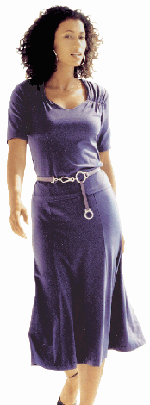 The challenges faced by the U.S. textile industry today are well known to the readers of ATI. These challenges are causing many companies to consider new strategies to maintain a competitive edge in the world marketplace. Faced with the incursion of inexpensive synthetic fibers from Asia, Wellman Inc., Charlotte, N.C., producers of Fortrel® polyester and Fortrel Ecospun®, recognized the necessity of choosing between two strategies for success — either to become a purely commodity-driven enterprise offering no distinguishing attributes to set its products apart from others in the marketplace, or, as Tom Duff, chairman, stated, “to be creative, innovative and unique enough to allow us to make a profit and give our customers differentiated products that they could make money on as well.”Spurred on by an additional challenge from Andy Warlick, president of Parkdale, the Gastonia, N.C., producer of cotton and cotton-blend yarns and a winner of ATI’s Award for Innovation, Wellman embarked on the latter path.
The challenges faced by the U.S. textile industry today are well known to the readers of ATI. These challenges are causing many companies to consider new strategies to maintain a competitive edge in the world marketplace. Faced with the incursion of inexpensive synthetic fibers from Asia, Wellman Inc., Charlotte, N.C., producers of Fortrel® polyester and Fortrel Ecospun®, recognized the necessity of choosing between two strategies for success — either to become a purely commodity-driven enterprise offering no distinguishing attributes to set its products apart from others in the marketplace, or, as Tom Duff, chairman, stated, “to be creative, innovative and unique enough to allow us to make a profit and give our customers differentiated products that they could make money on as well.”Spurred on by an additional challenge from Andy Warlick, president of Parkdale, the Gastonia, N.C., producer of cotton and cotton-blend yarns and a winner of ATI’s Award for Innovation, Wellman embarked on the latter path.
Warlick was looking for a new synthetic fiber that combined cotton-like aesthetics with theperformance of the most technologically advanced fibers on the market.
Over two years, the companies collaborated, combining Wellman’s chemical expertise and Parkdale’s understanding of cotton to produce Sensura™, “a fiber that we think will revolutionize the industry in the 21st century,” Warlick said.
Sensura’s Attributes
Sensura Type 870 staple fiber has a molecular structure with a rounded edge rather than the hard edge of a cotton molecule. It is low-pilling, semidull, optically brightened and disperse-dyeable. Wellman’s proprietary technology has produced a fiber that, according to various
tests, is superior to cotton in relation to perceived comfort, shrinkage, moisture-vapor transmission, wicking, drying time and pilling.
The fiber is also environmentally and economically superior because it dyes at lower temperatures than other fibers, therefore requiring less energy. It also uses no dye carriers and requires less dyestuff than other synthetics, further lessening its environmental impact.
Furthermore, it dyes in a range like most natural fibers. And, because lower dye temperatures are required, it is compatible with other synthetic fibers, such as spandex.
Sensura feels like the finest long-staple cotton — better than cotton, some would say. When combined with such fibers as spandex, it can even feel sensuous, almost like silk. It is resilient, colorfast, shrink- and wrinkle-resistant, durable and breathable. Because of its moisture-management properties — it dries 100 percent faster than cotton and moves perspiration from the skin through the fabric’s microclimate to evaporate on the surface — it keeps the wearer cool or provides insulation, according to the demands of the moment.
Sensura For Casual Lifestyles
With its ease of care and comfortable feel, Sensura is well-suited for activewear, casual sportswear and lingerie. It is also suitable for home fashions, such as knitted and woven sheets.
Warlick is optimistic about Sensura’s prospects for success, stating, “By working together with innovative mills and fabric designers, we believe Sensura has unlimited potential.” Fabrics currently in production include knits from Dyersburg Corp.’s Alamac Knits, Dyersburg Fabrics and
United Knitting; Kronfli Spundale Knitting; and Dolphin Trimming Inc. Other companies developing fabrics include Intex Corp., VF Knitwear, Nike, Patagonia, Pillowtex (Fieldcrest-Cannon), M.J. Soffee Co., Galey & Lord, Guilford Mills and Swift Denim.
For more information about Sensura, contact Joyce Basden, Wellman Inc., (704) 357-2066;
e-mail joycebasden@wellmaninc.com.
December 2000




